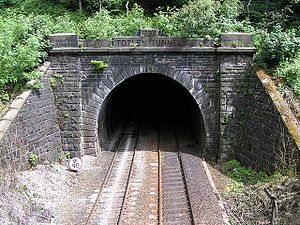Totley Tunnel


The Totley Tunnel is a railway tunnel beneath the Pennines in Derbyshire. It is 6,230 yards long on the former Midland Railway Manchester-Sheffield line. It extends between Totley on the outskirts of Sheffield westward to emerge at Grindleford.
The tunnel was completed in 1893 and was the longest railway tunnel in the United Kingdom after the Severn Tunnel (which is 1,434 yards longer.) After the two long High Speed 1 tunnels opened in 2007 it became the fourth-longest mainline railway tunnel in the UK.
The contractor for 1½ miles of the railway, including the tunnel, was Thomas Oliver of Horsham, Sussex.
Work began in 1888 with the construction of three brick-built surveying towers along the proposed line of tunnel, followed by a number of vertical shafts to the level of the rails. The Duke of Rutland had decreed that no more than one ventilation shaft should be sunk through his moors (and that work should cease from August to October, during the grouse shooting season). Initially four permanent and three temporary shafts were sunk near to the Totley end. The latter were cut through shale, and water was encountered in the first eight feet. The permanent ones took longer, encountering beds of ganister, coal and rock.
As the initial 10 ft x 9 ft headings were driven outwards from the base of each shaft, water flow increased to some 2.25 million gallons a day. At the Padley (Grindleford) end, the situation was little better, work stopping for several weeks until a drain was laid. Then at about 2000 yards a spring was encountered which flooded the workings at five thousand gallons an hour. A raft had to be used to inspect the workings. Shortly after this the shale became drier and work proceeded toward Totley, the headings finally meeting in 1892.
The tunnel was the proving ground of a number of boring machines for the shot holes, using gelignite to blast the rock. No limit was set on the amount, and in all some 163 tons were used. The atmosphere in the workings was hot, as well as humid, with compressed air used for ventilation, though, for a time at the Padley end, a turbine was installed in the Burbage Brook to drive a fan.
During the construction of the tunnel a natural cavern was discovered that was several hundred feet in area so it was decided to incorporate this into the design and a large air shaft was installed to the surface at this point. The entrance to the cavern can still be seen now on the Up side (towards Sheffield) of the tunnel half way through.
Because of the damp conditions, there were outbreaks of typhoid, in addition to diphtheria, smallpox and scarlet fever, not helped by the fact that accommodation was scarce, and the workers were living often twenty to thirty in a house. Working 24-hour shifts, as soon as one man got out of his bed, another would take his place, with little in the way of washing or sanitary facilities.
Because of its length, in addition to the Midland's normal block system, signal wires were installed which, when cut, caused alarms to ring in the signal boxes at each end. The same system was used in the shorter Cowburn and Clay Cross Tunnels.
Portals

- Western Portal: 53°18’17"N, 1°37’34"W SK250787
- Eastern Portal: 53°19’1"N, 1°32’32"W SK306801
Outside links
References
- Edwards, B., (1985) Totley and the Tunnel, Sheffield, Shape Design Shop
- Plans Relating to Dore & Chinley Railway: Section of strata in heading of Dore and Totley Tunnel, Derbyshire Record Office, File ref. D4107/5/1